How to size a pump

Water Booster Pumps are essential for maintaining proper water pressure in your home or commercial building. Whether you're upgrading an existing system or installing a new one, understanding how to size a water booster pump is crucial to ensure optimal performance. In this guide, we will explain the process of sizing a water booster pump and provide a glossary of terms commonly used within the industry.
What is a booster pump?
A water booster pump is a device designed to increase water pressure in a building's plumbing system. Its primary purpose is to ensure a steady flow of water at adequate pressure, especially during periods of high demand or when the natural water pressure is insufficient.
They work by utilising an electric motor to drive an impeller or a set of impellers. As water enters the pump, the impeller spins, creating centrifugal force that enhances the pressure and propels the water forward. This increases pressure allows the water to overcome any resistance or friction in the pipes, providing a consistent and reliable water supply at the desired pressure levels.
Benefits of a Water Booster pump
Water booster pumps or water pressure booster pump's main advantage is to increase the ability to boost water pressure, ensuring adequate flow and pressure for showers, sinks, toilets and other water dependant appliances and fixtures.
During peak usage times, such as when multiple showers are running simultaneously or when there is high demand for water in a commercial building, the natural water pressure may drop. A water booster pump ensures a steady and uninterrupted supply of water, maintaining optimal pressure levels throughout the building.
In some cases, low water pressure may lead to inefficient water usage, as individuals compensate by keeping taps open for longer periods or using more water to achieve desired results. By boosting water pressure, a water booster pump can help improve water efficiency.
Sizing a Water Booster Pump
Sizing a water booster pump is an important step in ensuring that your water system operates efficiently and meets your specific needs, It involves determining the flow rate and pressure requirements of your water system. Below are some of the question you may get asked, or you can ask yourself, so you can begin to understand what size system is required.
- How many baths are in the property?
- How many showers are in the property?
- How many wash basins are in the property (bathroom sinks)?
- How many toilets are in the property?
- How many sinks are in the property?
- How many washing machines are in the property?
- How many dishwashers are in the property?
- How many outside taps are in the property?
In addition to the above, we will also need to know how many floors are in the property, as you will need to deliver water to the highest floor at an ideal pressure. Generally, this is 2 bar. However, as the water travels through the pipework to the outlet, you will see a reduction in pressure due to pipe losses. It is good practice to factor this into your calculation when sizing a booster set.
If this something which you are unsure of, we have experience staff who can guide you through this process and help let you know what size pump you will need. For more information, please contact us
How to read a Pump Curve Graph
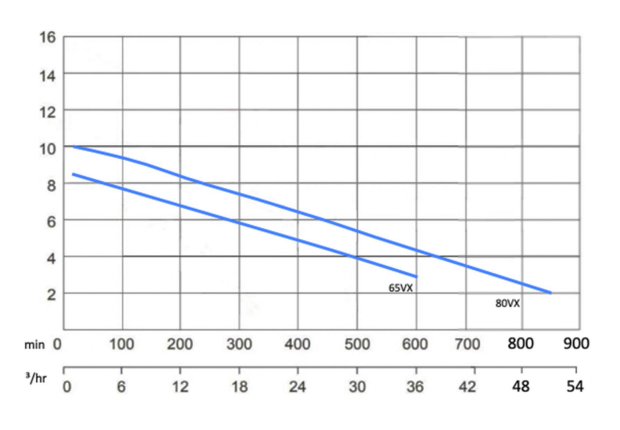
Above image Displays flow and pressure
Flow (x) axis - how much water the pump can move
Pressure (y) axis - also known as head, measures in feet or meters
The Mid curve is best efficiency point for any pump, either end is the maximum the pump can work at (which if kept constant the pump would burn out) and the minimum the pump can work at.
When reading a booster pump curve, it involves understanding the information presented on the curve and using it to determine the performance characteristics of the pump. Here's how you can read a booster pump curve:
1. Axis Labels: The pump curve will have 2 main axis - the vertical axis (y-axis) and the horizontal axis (x-axis). The y-axis typically represents the pump's head (pressure) in units such as meters of feet, while the x-axis represents the pump's flow rate in units such as gallons per minute (GPM) or litres per second (L/S)
2. Performance Curve: The pump curve is a graphical representation of the pump's performance. It shows how the pump's head (pressure) varies with respect to the flow rate. The curve is typically a line or a series of data points that connect the points of operation for the pump/
3. Operating Points: The pump curve will have one or more operating points marked on it. These points represent the flow rate and head (pressure) at which the pump operates under specific conditions. The operating points are determined by the system requirements and the pump's performance capabilities.
4. Efficiency and Power: Some pump curves may also include additional information such as efficiency and power consumption. Efficiency represents the ration of the pump's hydraulic power output to the input power and is usually shown as a percentage. power consumption refers to the amount of electrical power required to operate the pump.
5. Interpretation: To read the pump curve, locate the operating point or desired flow rate on the x-axis and follow it vertically unit intersects with the pump curve. Then, read the corresponding head (pressure) value on the y-axis. This will give you an indication of the pump's performance at that particular flow rate.
It's important to note that pump curves are specific to each pump model and are provided by the manufacture. They are used to select the appropriate pump for a given application and to understand its performance capabilities under different operating conditions.
By understanding how to read a booster pump curve, you can make informed decisions about pump selection, system design, and troubleshoot in order to meet the desired flow rate and pressure requirements.
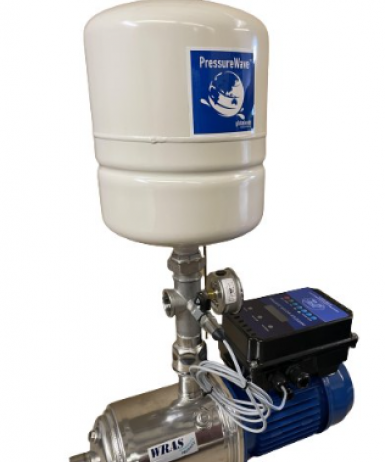 Single Booster Pumps
Single Booster Pumps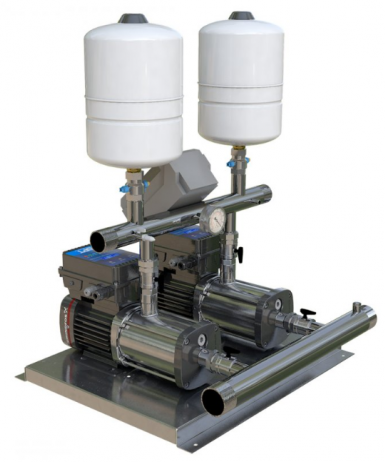 Twin Booster Pumps
Twin Booster Pumps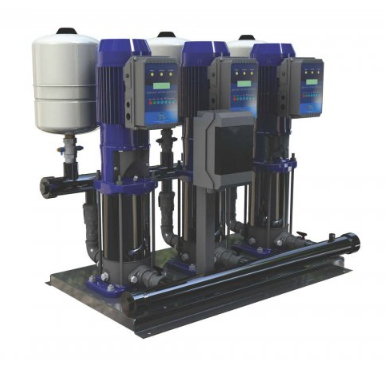 Triple Booster Pumps
Triple Booster Pumps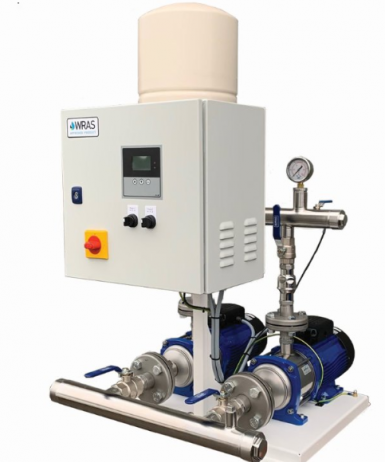 WRAS Approved Booster Pumps
WRAS Approved Booster PumpsGlossary
Flow Rate
Also known as volumetric flow rate, is a measure of the amount of fluid (liquid or gas) that passes through a given point in a specified period of time. It is typically expressed as the volume of fluid that flows per unit of time, such as litres per second or cubic meters per hour. Flow rate is influenced by factors such as the diameter of the pipe or channel through which the fluid is flowing, the pressure difference across the system, and the viscosity of the fluid.
Friction Loss
Friction loss refers to the pressure drop or energy loss that occurs due to the friction between the fluid and the walls of a pipe or conduit. It is a common term used in fluid mechanics and is particularly relevant in the design and analysis of piping systems. Friction loss is influenced by factors such as the diameter and length of the pipe, the viscosity of the fluid, and the flow rate. It is typically expressed in units of pressure, such as pounds per square inch (psi) or pascals (Pa) and is an important consideration in determining the efficiency and performance of fluid flow systems.
Max Head
The term 'Max Head' refers to the maximum height or pressure that a pump can generate and maintain against gravity (when pumped straight up). It is a measure of the pump's ability to lift or push fluid to a certain height. The max head is typically expressed in units of length, such as meters or feet, and is an important specification when selecting a pump for highest point to which the pump can deliver fluid and is influenced by factors such as the pump's horsepower, impeller design, and system resistance. Understanding the max head is crucial in ensuring the pump can meet the required pressure or height requirements of a specific system or process.
Pressure Tank
A pressure tank, also known as a pressure vessel, is a container used to store and regulate the pressure of a fluid or gas. It is designed to withstand high pressure and is commonly used in various industries and applications. Pressure tanks are typically made of sturdy materials such as steel and are equipped with pressure relief vales for safety purposes.
The main purpose of a pressure tank is to maintain a constant pressure in a system by storing excess fluid or gas when the demand is low and releasing it when the demand is high. This helps to reduce the cycling of pumps or compressors and ensures a steady flow of fluid or gas, Pressure tanks are commonly used in water supply systems, hydraulic systems, pneumatic systems, and many other industrial processes.
In addition to regulating pressure, pressure tanks can also serve as a reservoir for emergency backup supply, provide surge control, and help prevent water hammer effects in plumbing systems. They come in various sizes and designs to accommodate different pressure and volume requirements.
Loads
Refers to the amount of work or pressure that the pump needs to generate in order to overcome the resistance in a fluid system and deliver the desired flow rate.
Booster pumps are commonly used to increase the pressure of water or other fluids in a system, such as in buildings or industrial application, where there may be a need for higher water pressure. The loads in this case refer to the pressure requirements of the system.
The loads on a booster pump can vary depending on the specific application and requirements. factors that determine the load include the desired flow rate, the distance the fluid needs to be pumped, the elevation or height the fluid needs to be lifted, and any friction or resistance in the piping system.
Summary
To properly size and select a booster pump, it is importance to consider the loads or pressure requirements of the system. This involves calculating the total head or pressure that the pump needs to generate to overcome the resistance and deliver the desired flow rate. It also involves considering factors such as the system's peak demand, any pressure losses due to friction, and any additional pressure requirements for specific equipment or fixtures.
Read More from Tanks Direct
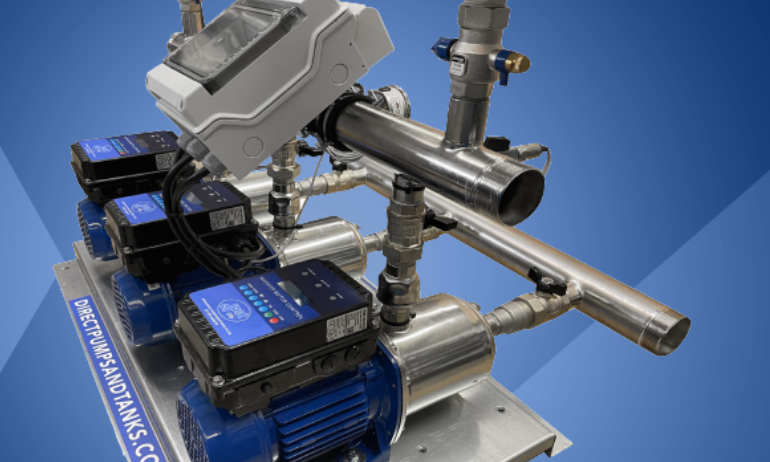
Water Booster Pumps Explained
Water Booster Pumps Explained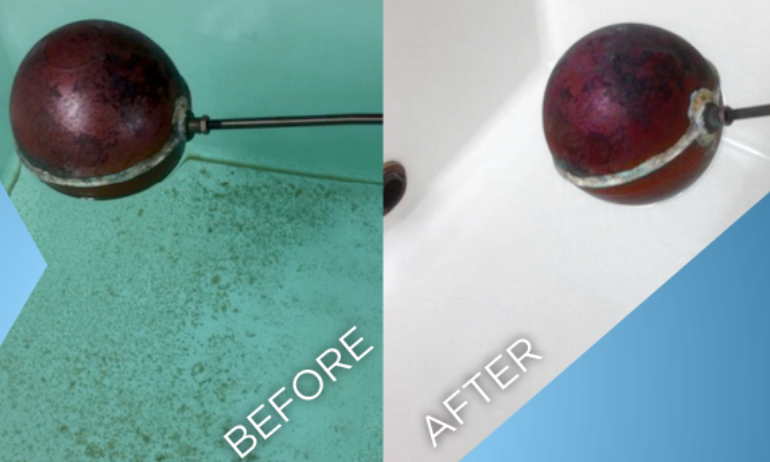
Does your water tank need a clean?
Does your water tank need a clean?
Frequently Asked Questions
Pumps
Booster Pumps
What is the difference between water flow and water pressure?
There are differences between water pressure and water flow. Water flow is the volume of water delivered and is measured in litres per minute. Water pressure is the force or speed the water is delivered. Both are affected by the size and condition of the pipe work the water is flowing through.
Can I boost mains water pressure?
It is possible to boost mains water pressure. To do this a booster pump can be fitted to the mains cold water supply. In compliance with water fitting regulations, this is up to 12 litres per minute. Generally, a mains booster pump can improve the performance of all the water appliances and fixtures in your home.
Why do i have low or no water pressure?
If you use lots of appliances at the same time you water pressure will reduce, such as dishwashers and washing machines. If you have an older property, you may find your water pipe is smaller than those used in modern houses. Smaller pipes supply less water and can reduce pressure and flow.
When water pressure in your house is low, it is most likely the water pressure coming into your house is lower than the property requires. However, if you notice that the low pressure is only to just one or a few appliances then it could be an issue with that fixture, or a pipe that runs into your property.
The amount of water pressure in your home may vary depending on the time of the day and the ground level of your property. Check that the water meter valve and the main shut off valve are fully opened.
However, while these factors play a part, your water authority is required to supply a minimum of 0.7 bar of pressure. If the mains pressure into your property is consistently low, you may need to fit a booster pump to your plumbing system.
To see our full range of booster pump sets, please click - Booster Pump Sets
What is water pressure and what causes it?
Water pressure is the force water that is pushed through water pipes into premises. This pressure determines how quickly water flows from your taps, shower heads and appliances such as washing machines and dishwashers.
If the water pressure in your household pipes are low, then water will flow slowly out of your taps or shower, taking it longer to fill up a sink, bath or shower. This is especially true for an upstairs bathroom (after all, the water may need to travel upwards against gravity to get to the source)
Water pressure is measured in bar or psi (pounds per square inch). One bar of water pressure is needed to raise water 10 metres high, so the higher the water must travel, the lower the water pressure will be.
Gravity creates pressure naturally, so when your water comes to you, it is already pressurized. In some cases, booster stations help to maintain the pressure throughout the water lines. If your water comes from a private well, then your water is pressurized through a tank that maintains a range of pressure
The systems are described as plug and play, do I still need it commissioning?
Commissioning would be recommended. These are specialist systems and without a commissioning visit, there is no peace of mind with the end user that the warranty as not been affected due to incorrect installation. Incorrect operation is easily done if the system is not correctly commissioning, so this is a service we offer ourselves, so there is a clear line of liability if something was to go wrong with the set, this protects everyone.
I’m not sure what I need, or if it can fit, can somebody come and measure it up?
This is a service we can carry out, however with the use of modern technically, we only require the standard set of information, and then just basic measurements of the space it is going into, widths of doors and room space etc, all of this we can now do with the use of online video calls and pictures.
I have limited space to install the system in my property, what do I do?
This is a common issue, which is why we offer a compact solution as the Flyvar Booster system which is a compact system where the pump(s) are in the tank to save space, these can also be installed externally with the addition of an inverter housing cover, to protect it from the elements.
Do I need a single or twin pump system?
This depends on a couple of factors, the demand of the building if you want it sharing across 2 pumps, but also the importance of the water supply, for example, manufacturing facilities who need wash down cannot afford the downtime of a single pump etc. With a twin pump system, you can share the duty across 2 pumps, which both pumps would run at 50% of total duty, or on duty standby, where each pump would be capable of 100% of total duty.
What size pump and tank do I need?
For this, we would require a breakdown of the cold water outlet for the whole property, i.e. 2 W/C’s, 4 Wash hand basins and a shower. Once we have calculated the building water demand, we can then specify the right storage tank, this is an industry standard of a capacity to cope with a 10-minute run time at full demand, most 3-4 bedroom properties for example work out at around 250L.
For most single property installation, pressure isn’t a huge concern, as low head booster systems that run up to 3 bar will produce more than sufficient pressure for a 2-story property.
I have poor water pressure in my house, what do I do?
Due to regulation, you cannot pump directly onto a mains water line for the whole property, without storing water and creating an overflow. To achieve this we supply the boosters systems with break tanks, as they are commonly known, to compliantly store the water to act as a reservoir and which the pump draws from.
What size cold water break tank do i need to help boost water pressure?
Break tanks are used to help boost pressure within a water system, where the current water pressure is not strong enough to supply the requirements of the building. Typically, break tanks are fitted with an air gap between the inlet and maximum water level to prevent backflow into the mains water supply.
To determine the size of the break tank required, there are a few things to consider.
Occupancy of the building
This is a big factor, as you need to understand how much water is required within the property. For example a hotel requires more water storage per bed space than a hostel.
Below are some examples of recommended minimum storage levels for each type of premises.
Hotel - 200 Litres per bed space
Office without Canteen - 40 Litres per employee
Office with Canteen - 45 Litres per employee
Restaurant - 7 litres per meal
Primary School - 15 litres per pupil
Secondary School - 20 Litres per pupil
Nursing Home - 120 Litres per bed space
(Source: BS EN 806 Part 2)
Please consider when using this calculation, the peak occupancy of the building.
When sizing for a domestic building, a rough guide of 90 litres per bed space should be sufficient, however high-end properties may require additional storage.
Another consideration would be the expected peak flow of the premises. This is calculated when sizing a booster set. In determining the peak flow rate, we must consider how much water storage must be provided to facilitate this flow rate.
Tanks Direct recommend that a minimum of 15 minutes' storage, according to the peak flow rate of the booster set, should be provided in a booster set break tank within a commercial installation. For example, a booster set with a peak design flow rate of 1.1 litres/second, or 66 litres/minute, requires a break tank with a capacity of at least 990 litres.
Other factors such as the tank inlet flow rate and the usage patterns of the building should also be taken into account - buildings with a poor rate of mains water supply will require greater storage. This will also be influenced by the siting of the break tank - a tank on the ground floor of a building will fill at a higher rate than a tank on an upper floor or in the roof space. Siting a tank in the roof space of a building is likely to necessitate a larger storage volume.
What's meant by a 'Booster Pump Set'?
There are two reasons why water may need to be boosted: (1) to give a better flow and pressure at the draw-off point in a domestic situation, or (2) as a method of raising the water supply in high-rise buildings above the height that the mains will supply.
A booster pump set, helps to get to optimum pressure within the current system, so you should get constant water pressure whether you are downstairs in the kitchen or up on the 3rd floor having a shower.
‘Packaged’ pumping sets or Booster Sets are installed consisting of dual pumps (unless single pump is selected, then this would only be one pump) to overcome the problem of failure of (or the need to renew) one of the pumps. The second pump also assists at times of high demand on the system, cutting in as necessary. To prevent pump seizure and stagnation of water, the pumps should be designed to work alternately. Two types of system will be found: those using pressure-sensing devices and those using float switches.
General
What type of water pump is right for me?
Choosing the right water pump for your needs is essential for effective water maintenance. We stock a wide range of water pumps, so first you need to determine the type of water pump you need.
Wastewater or sewage pumps move wastewater from one part of a system to another. We offer a range of wastewater pumps in different capacities and configurations and come with a variety of features.
If you live in an area with low water pressure, our booster pump sets can increase the water pressure in your home or office.
Chemical pumps are designed to move fluids containing hazardous chemicals without risking exposure or damage to the pump or surrounding equipment.
Pressurised pumps are used to transfer fluids that require pressurisation.
Made from a composite material of glass reinforced polyester, GRP pump enclosures are highly durable and offer excellent protection from the elements.
Submersible pumps are a type of water pump that can be submerged underwater to pump out water. This type of pump is typically used in flooded areas or to pump out water from ponds, wells, or other water sources.
Swimming pool and garden pumps circulate water in a swimming pool or pond. The pumps work by creating suction to draw water from the pool or pond, and then using an impeller to push the water through a filter.
Our flood kits have what you need in the event of a flood.
On my Water Pump it mentions about head height. What is this and how do I work out what I require?
Head is the height in which the pump is lifting the waste, measured from cover level of the pump station, to the cover level of the discharge manhole. With this measurement we can ensure we supply a pump powerful enough to lift the waste up that high. We will need to know this and also the distance that it is pumping to make sure the pump quoted is suitable.
What is the best water pump for flooding?
Submersible pumps are very good at dealing with groundwater flooding and rainfall. Designed to operate underwater, they work by using electric motors to draw water from flooded areas and divert it away from buildings and other areas that need to remain dry. Submersible pumps are commonly used to drain water from flooded basements and other areas that are prone to flooding.
We stock a wide range of submersible pumps, that are easy to install and maintain. They can be connected to pipes and other water control systems, allowing for quick and easy water removal in the event of flooding. They are designed to operate in a wide range of temperatures and conditions and are typically constructed from corrosion-resistant materials that can withstand long periods of exposure to water. Our submersible pumps are often equipped with protective measures, such as float switches and check valves, to prevent any damage to the motor or pump should the water start to rise too quickly.
Also known as sump pumps, submersible pumps are a type of centrifugal pump that can be operated when fully submerged underwater. Sealed so the electrics are protected, our range of submersible pumps can be used for a variety of applications including puddle drainage, swimming pool pumps, pond and water feature pumps, and drainage pumps.
What are the main types of water pump available?
Here at Tanks Direct we have a huge selection of water pumps available.
Wastewater or sewage pumps are used to move wastewater, or water that contains solids and contaminants, from one place to another. They are commonly used in various industrial, commercial, and residential applications to move wastewater from a source to a sewage treatment plant or to another location entirely.
Booster pump sets are used to increase water pressure. Booster pumps work by taking in water at a low pressure and increasing it to a higher pressure with a centrifugal impeller. Booster pump sets are ideal for areas where the water pressure is too low to provide adequate water flow.
GRP pump enclosures are made from a composite material of glass reinforced polyester (GRP). Requiring little maintenance, GRP pump enclosures are highly durable and offer excellent protection from the elements and corrosion.
Submersible pumps are designed to operate while completely submerged in a fluid.
Swimming pool and garden pumps are used to circulate water in swimming pools, hot tubs, water features, and gardens. They keep the water free of debris and maintain the desired water temperature. The pump typically pulls water from the pool or garden and pushes it through a filtration system before returning it to the pool or garden.
Are there any disadvantages to using variable speed pumps?
1. Vibrations
Although running pumps below their maximum speed will tend to reduce overall system noise, altering the speed of a pump may result in structural resonances that would not occur at the pump's maximum speed. This may cause vibration which can be harmful to equipment and cause an increase in noise at certain frequencies. There are a number of products that help to alleviate these potential issues.
2. Higher initial cost
Because of the added complexity of an inverter drive, variable speed pumps and systems which include variable speed pumps will cost more initially than a fixed speed equivalent. However, this additional cost is invariably outweighed by the long-term energy cost saving.
When should variable speed pumps be used?
Variable speed pumps should be used in any installation where the pump duty is not constant. If a pump duty is constant a fixed speed pump may be the most cost-effective option. However, even in fixed duty applications there may be an advantage to running a pump below its maximum speed. A motor running at 80% of its maximum speed uses 48% less energy.
Why variable speed pumps?
When you consider all the pumping that occurs globally, whether in large industrial plants or in domestic heating systems, this accounts for almost 20% of the world's energy consumption. Because of this there is a huge opportunity in the pumping industry to make a significant contribution to using our energy resources efficiently. In pumping applications where the duty required is not constant, it is highly likely that installing a variable speed pump will result in significant energy savings - likely to be between 30% and 50% in many applications.
Other benefits of variable speed pumps include:
1. Improved reliability
Because variable speed pumps run at speeds below their maximum, there is a reduction in wear, particularly in mechanical seals.
2. Improved control
Variable speed pump controller can monitor small variations in pressure and make adjustments accordingly. This also means there is less liklihood of sudden changes in flow or pressure.
Do waste pumps need servicing and if so, how often should this be done?
Waste pumps and your wastewater system in general need regular servicing to keep it in working order. A general desludging of your system and a check of the components such as the sewage pump will keep the sewage treatment system in good working order for longer.
Generally, a good rule of thumb for servicing your sewage pump would be every 1 to 2 years or every time you empty your septic tank. It is a good idea to get it checked regularly to avoid a costly replacement further down the line.
When to choose a 65mm or 80mm vortex pump over a 50mm vortex pump
If you are concerned about the risk of blockages but also need a flow rate which macerator pumps can’t provide, or even if it’s purely just a faster flow rate you need, a larger 65mm or 80mm pump will be able to achieve this, calculating a specific flow rate to your application is difficult and would be best speaking to a member of our technical team to help specify the right pumps for your station.
Why choose a macerator pump over a vortex pump?
If you have an application where the risk of blockages that could enter the drain run is higher than usual, for example if the property is rented, tenants could unwillingly block the pump, this is also a problem if it is an apartment block as you wouldn’t be able to source who was responsible for blocking It, but everyone would need to pay their share to fix it.
Also, macerator pumps, because of how they cut through the waste, they can pump a much higher head (vertical distance), so when compared to vortex pumps, if you have anything over 10m, you will need to be selecting macerator pumps. Always check the pump flow curves for your application or you can call to speak to one of our technical team if you want to be sure the pumps will do the task at hand.
Automatic Pump - what does this mean?
An automatic pump is a pump that will automatically turn itself on and off as the liquid level rises and falls. These pumps are usually longer lasting as they do not burn out but switch off automatically if there is no liquid to pump therefore, they do not run dry.
What is a submersible pump?
A submersible pump means that the pump needs to be submerged or covered in liquid specifically the type specified on the pump such as water, wastewater, sewage etc.
What is a Grinder Pump?
A grinder pump takes the wastewater from the holding tank, grinding any waste into a fine slurry and then pumps it into a sewage treatment plant. They can pump over much longer distances but at a slower rate because they are high pressure and low volume pumps.
To see our grinder pumps click - https://www.tanks-direct.co.uk/semisom-125-gr-automatic-submersible-grinder-pump/p5628
Is there an option to have an enclosure for my pump set?
If a booster or compact set is being housed externally, you will need an enclosure to protect the inverter from the elements so anything electronic needs to be protected by an enclosure of some sort, never leave the booster set to face the elements
How much space do I require around my pump?
You require at least 500mm above the break tank so you can service it and inspect it when required. Also, a booster just needs to be installed in a maintainable space so that the inverters can be reviewed if needed via clear walkways and facing into the room, not tucked away down the side of a plant room.
Horizontal vs Vertical pumps
This depends on your existing pump and the type of installation you have or are planning on. The vertical Hippo 50 has a vertical port discharges via a 2” female port and the horizontal Hippo 50 discharges via a horizontal 2” female port but is also DN50 flanged
Do I need a macerator?
Macerator pumps are used only for heads higher than 10m and with a low flow rate when you have a discharge rate restriction imposed by the water authority who own the sewer you discharging into.

 Login
Login